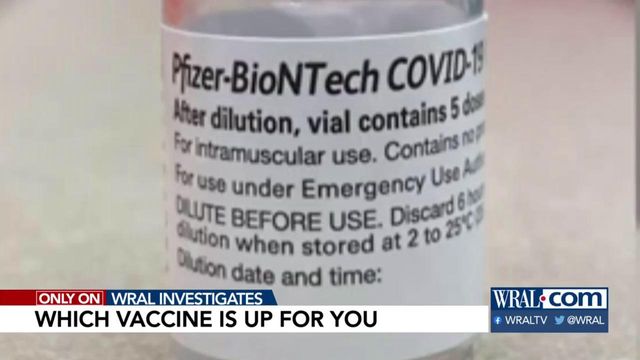RALEIGH, N.C. — As counties open up enrollment for the COVID-19 vaccine, many people are wondering which vaccine is the best choice.
WRAL Investigates read through the Moderna, Pfizer and Johnson & Johnson Emergency Use Authorization applications and spoke to Dr. Chip Walter, who serves as the Duke Human Vaccine Institute chief medical officer and directs the Duke Vaccine and Trials Unit. Below is that discussion, as well as an easy-to-follow chart on the differences between the three vaccines.
Dr. Walter: The good thing is we now have three different vaccines to prevent COVID-19 infections and really all three are very effective at preventing serious infection between 85 to 95% effective at preventing serious illness, so that’s the really good news when we started off with hoping for a vaccine that was 50% effective. So, number one, good news.
Number two, I think in terms of differences, two of the vaccines are very similar. They’re made, they’re mRNA vaccines, the Pfizer and Moderna vaccines are really quite comparable.
The third vaccine is the J&J or Johnson & Johnson vaccine which is an adenovirus vector vaccine.
So they’re slightly different, but the principle behind all the vaccines is really the same. It delivers a blueprint so that the body can make the spike protein and that your body from there will mount an immune response to that spike protein, which is the major protein on the surface of the COVID-19 virus.
Dr. Walter: I would say neither of them are the way we’ve always done things. Both types of vaccines have been in development for a number of years. The mRNA vaccines have been tested against numerous viruses, but none of them to date had received any approvals, whereas the adenovirus vector vaccine also was kind of a newer technology, but probably had been used a little bit more widely for things like Ebola.
Dr. Walter: Absolutely. I think that’s why I led off saying we have three vaccines all more than 87% effective against severe disease, and I think when you look at what you want to do, you want to prevent hospitalizations and severe infections for COVID-19, so that’s really the most important thing.
We do get hung up on trying to compare the efficacy of one or two of them being around 95% and one that may be a little bit lower, but you can’t really compare the efficacy because they were all really tested in different studies, at different times and in different locations. So to really compare the efficacy you would have to do that in a head-to-head study at the same time in the same location.
Dr. Walter: I don’t think at this point we really want to say that. We haven’t really compared them head to head. They all look really effective in different populations – younger, older, different racial/ethnic groups, people with underlying co-morbidities – so I don’t think we really want to limit ourselves. The best vaccine is the vaccine you can get. Now that people may have a choice, which is a good thing, I would base it more on convenience.
Dr. Walter: I don’t think I would necessarily pick one over the other. Good try! But I don’t think I would pick one over the other. I would base it on my situation. You know, if I had anticipated travel travel in three to four weeks and wasn’t necessarily having time to go back and get the second dose (Moderna and Pfizer) or I had an extremely busy life and didn’t have time to go back and get a second dose, then J&J would be a good option.
Dr. Walter: I don’t think there are really any reasons to choose a specific vaccine. They’re all really highly effective against what we want to prevent: hospitalizations and severe COVID-19 illness. So I think any of them are okay. I think in terms of side-effect profile, any of them are okay. If you knew you were potentially allergic to a component in a vaccine, and that may be really hard for the average person to know, then that may be a reason to go for another vaccine.
Dr. Walter: Some people are getting vaccinated, although we’re only around 10% of the population or something like that or those with prior infection. I think what we do know is we need about 70 to 80 percent of the population to be immune in order to really interrupt transmission and produce herd immunity. In order to achieve that, we need to get a significant portion of the population vaccinated because you’re never going to achieve herd immunity through everybody having infection.
Pfizer
- 96% efficacy against severe illness (100% against infection)
- 2 shots with a total of at least 35 days until complete coverage
- Ages 16 years and up
- 83% of trial recipients reported localized pain and/or side effects after the shots
Moderna
- 94% efficacy, but trials showed a drop to 86% with people 65 and older
- 2 shots, 42 days until total coverage
- 18 years and up
- 87% of trial participants reported some post-shot localized pain
Johnson & Johnson (also called Janssen)
- 85% effective against severe illness
- 1 shot, 28 days until complete coverage
- 18 years and up
- 49% reported pain from shot or related symptoms





